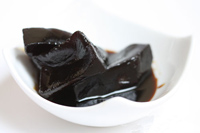
Origin: Murcia

The word arrope derives from the Arab arrúbb, which means "thick or dense stew". Arrope's consistency must be thick and syrup like, and is quite like a marmelade in many ways. It's main ingredient is grape must which is in common supply in Spain - a country which contains a large amount of vineyards. Then according to each region different elements are added, such as dried fruits and nuts, pumpkin or melon macerated with cinnamon or violets, etc. Naturally the type of fruit or other additional ingredients in the past would have depended entirely on what would grow in people's back gardens.
Within the Spanish gastronomic tradition, arrope is one of the first candies that were created. However instead of using sugar or honey, like other Spanish candies, such is the case with guirlache, it's made with grape must. Since the 8th century, the time of Al-Andalus in most of the Iberian Peninsula, arrope has been made as desert or to sweeten certain dishes.
In the time of post Spanish civil war era arrope was the Nutella of it's time. Mother gave arrope to their children for tea time or as snacks, spread on bread, as desert, etc. The objective was to give the growing children something sweet with a high calorie content during a time when sugar was rationed and many products were scarce.
A curious anecdote of it's preparation in the past was the use of quicklime to elaborate the water that would be used for cooking it or even to harden the chunks of pumpkin that would be used in the mix. Many grandmothers would make the most of an abundant grape harvest to make great quantities of arrope that would last throughout the year. Although arrope is consumed at any time of the year, it's traditional to eat it on Halloween.
There are of course a number of varieties of this dish. One of them is called 'aguamiel' which means 'honeywater' and is made in certain zones of the Spanish region of Extremadura. To make this version, they use honey instead of grape must, however the production process is the same. The syrup even made it across the Atlantic and there are several versions made in the Latin American country of Argentina. Here it tends to be made with carob beans, figs or other fruit and is often eaten as an accompaniment to goat's cheese.
Many fruits, nuts and spices can be used in its elaboration, it's only a matter of creativity and imagination. This means that the mixture can be whatever you like, and is therefore adaptable for many purposes. You could add raisins to it and it would make a great sauce for rum and raisin ice cream. Or you could add fruit and make it into an alternative to jam or marmelade for your morning toast. The choice is yours!
Ingredients:
Preparation:
Remember that you can add any fruit you like to the mixture. We recommend you try arrope and many other delicious candies that Spain has to offer! Just remember to brush your teeth after all of that sugary goodness!